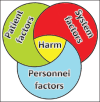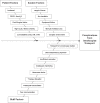Complications during intrahospital transport of critically ill patients: Focus on risk identification and prevention
- PMID: 26807395
- PMCID: PMC4705572
- DOI: 10.4103/2229-5151.170840
Complications during intrahospital transport of critically ill patients: Focus on risk identification and prevention
Abstract
Intrahospital transportation of critically ill patients is associated with significant complications. In order to reduce overall risk to the patient, such transports should well organized, efficient, and accompanied by the proper monitoring, equipment, and personnel. Protocols and guidelines for patient transfers should be utilized universally across all healthcare facilities. Care delivered during transport and at the site of diagnostic testing or procedure should be equivalent to the level of care provided in the originating environment. Here we review the most common problems encountered during transport in the hospital setting, including various associated adverse outcomes. Our objective is to make medical practitioners, nurses, and ancillary health care personnel more aware of the potential for various complications that may occur during patient movement from the intensive care unit to other locations within a healthcare facility, focusing on risk reduction and preventive strategies.
Keywords: Complications; critically ill patient population; intrahospital patient transfers; never events; patient safety.
Figures



References
-
- Schwebel C, Clec’h C, Magne S, Minet C, Garrouste-Orgeas M, Bonadona A, et al. OUTCOMEREA Study Group. Safety of intrahospital transport in ventilated critically ill patients: A multicenter cohort study*. Crit Care Med. 2013;41:1919–28. - PubMed
-
- Szem JW, Hydo LJ, Fischer E, Kapur S, Klemperer J, Barie PS. High-risk intrahospital transport of critically ill patients: Safety and outcome of the necessary “road trip”. Crit Care Med. 1995;23:1660–6. - PubMed
-
- Stawicki SP, Galwankar SC, Papadimos TJ, Moffatt-Bruce SD. Gurgaon, Haryana, India: Wolters Kluwer Health (India) Pvt. Ltd; 2014. Fundamentals of Patient Safety in Medicine and Surgery; pp. 5–78.
Publication types
LinkOut - more resources
Full Text Sources
Other Literature Sources

